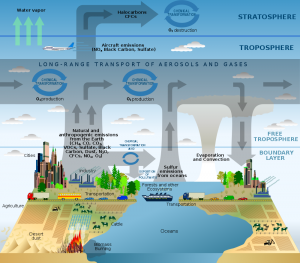Air pollution is not a new subject, but a pressing one. It concerns us in terms of causes, effects and long term mitigation. Often, media speaks about rising CO2 levels and the catastrophic results that this augmented release might have on life on Earth. It is true, carbon dioxide is poising a threat, but it is not the only source of concern. Every day, our ordinary activities or natural processes generate enormous amounts of nitrogen oxides (NOx) and particulate matter (PMs), methane (CH4), carbon oxides (COx), ozone (O3), volatile compounds (VOCs) and other perilous substances. All these can be found on the different levels of our atmosphere, from close to the ground to up in the sky, beyond the boundary layer and represent a hazard to our health and well being.

Scientists have long studied the impact of air pollution on the human population and unanimously concluded that there is an established cause-effect link between the two. Their findings are largely based on data from networks of air quality stations and satellite measurements, however, in order to correctly quantify this influence, a much greater insight should be gained. While these have proven to be valuable sources of information, air quality stations networks are sparse and do not cover evenly large areas. Moreover, satellite information usually delivers aggregated information, as they need to compensate for the broad area examined. Having a combination of professional sensors, remotely sensed data and local measurements can optimize prediction models of air movement and compounds and help us understand more about what are we breathing daily.
But who can provide the local measurements?
The unanimous answer is citizens. Inhabitants can contribute to the advancement of science, even with little scientific training. Citizen science is more popular then ever. Engaging millions of people has a range of rewarding sides: improvement of the number of scientific measurements, obtaining data easily and with less costs, connecting people to their environment and making them aware of the problems surrounding, opening science to a non-restricted number of trained individuals and promoting scientific creativity and engagement. In paper (1) published in Science in 2014, authors residing at research and governmental agencies across the US, debate about the necessity of placing strategic investments and enhance coordination for citizen science to reach its full potential, arguing about the technology improvements (easy connection, functionalities and accessibility), social and environmental impact and scientific performance.
Of all topics, air quality is one that have witnessed the most success and where actions can have an immediate impact. Governmental bodies such as the European Union offer great support to these initiatives, offering funding and facilitating the access to infrastructure and expertise (e.g hackAir project). In the US, the Environmental Protection Agency (EPA) is establishing its own projects, delivering sensors to the population in pilot areas and considering implementing such a network for a long period. Other communities collaborate on similar endeavors with the aid of NGOs or local groups (the Curieuzen Neuzen in Belgium is a good example). New businesses offer the possibility to order or buy a pre-built kit and start measuring in pilot experiments or by pure curiosity. AirQualityEgg, IQAir, SmartCitizen, are all successful examples. Friends of the Clean Earth and similar NGOs/think tanks are making use of these kits in their projects, where they encourage citizens to participate, by offering them the means and training. Similar actions are popular among students on campuses and scientists that use the data mixed in their own research and is now spreading to the classrooms.
Why air pollution?
The answer resides in the easy-to-quantify effects and the manner public perceives the threat. Health problems represent a poignant issue, cardiac and respiratory conditions being affected by the poor quality of our air. If we think about systems, pollution in cities affects our infrastructure, can pose major problems to the transport system and affect us also indirectly.
Records of the gaseous and particulate components in our atmosphere are commonly measured at fixed air quality stations. But air is not stationary, it moves around the city and it’s charge can vary with location, time and weather conditions. Winds can facilitate the transport of particulate matter and gases, and spread the pollution cloud far beyond the origin. Researchers and decision bodies rely heavily on models that are fed with data coming from the local stations and satellites. However, these models contain errors, due to scarce spatial and temporal sampling.
A much more varied and spread network of sensors is needed. Luckily, air quality sensors are easy-to-find and come in cheap prices. As mentioned, pre-built kits can be procured on the internet, but vor amateur scientists there are also some other engaging solutions: build your own. Different components (CO2, PM, temperature, humidity, GPS, NO2, etc.) can be ordered online and attached to a programmable motherboard such as an Arduino or a Raspberry Pi which are very popular and cheap, for creating custom air quality stations. A wealth of on-line resources and passionate communities makes it easy to gain the necessary skills for programming and assembling together our own air pollution sensors. Other more rudimentary solutions (e.g buckets and vacuums, sheets of cardboard painted with vaseline) can also add up to the variety of experiments that compose the air quality citizen science techniques ecosystem.
Not only that but training is also available at the expense of a couple of mouse clicks. EPA for example offers the Air Sensor Toolbox, a collection of kits, tutorials and support for those interested in contributing. The National Aeronautic and Space Administration (NASA) runs projects implemented with the aid of citizens, such as Air Quality Citizen Science. Other Massive Open Online Courses (MOOCs) teach people about climate and air quality (e.g EdX Air Quality or Indoor Air Quality on Coursera). Information about the topic is easy to find and handy.
The possibility to easily contribute and fast deploy your own sensor or conduct your own experiment, coupled with the wealth of educational resources and support, has led to a growing community eager to contribute and you can be part of it!
The ESA air quality citizen science experiment
As a promoter for open science and creative research ideas, the European Space Agency supports citizen science and it is an active advocate of it. While using crowdsourced information from a number of other initiatives, the Air Quality School Lab experiment is aiming to promote citizen science to classrooms and educate young generations in the spirit of science and collaboration. The experiment is integrated in the School Lab event, that will run during the Living Planet Symposium 2019 in Milan. Read more about how you can contribute to the School Lab can be found here.
References:
1. Bonney R., Shirk J.L., Phillips T.B., Wiggins A., Ballard H.L., Miller-Rusching A.J, Parrish J. K., 2014, Next Steps for Citizen Science, Science, vol 343, pages 1436-1437


